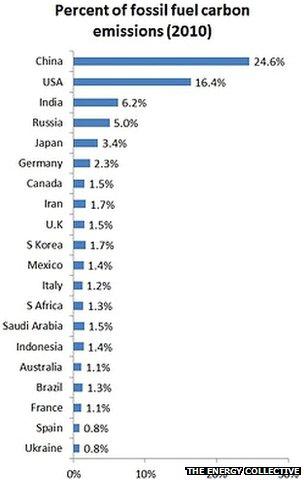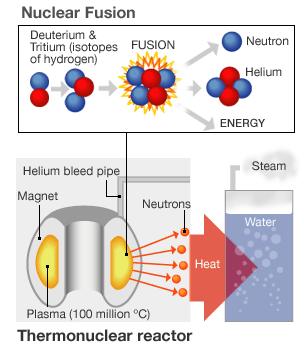Dirty secrets: What's behind carbon's rise?
- Published
- comments

The reports show "clean" technologies are not being adopted fast enough to stave off climate impacts
Late last week, Oak Ridge National Laboratory (ORNL), which hosts the US's official emission-counting agency, released data, external showing a huge surge in carbon dioxide emissions from 2009 to 2010.
Now, consultants Pricewaterhouse Coopers (PwC) has an analysis, external showing that greenhouse gas emissions rose by more than economic growth.
And this in a world where the vast majority of governments have endorsed reports, external saying that man-made climate change is set to bring serious impacts to societies and economies unless it's checked.
So what's going on?
The ORNL data shows a much higher growth in developing countries than in the developed world.
We're talking about CO2 emissions from fossil fuel burning and cement manufacture here.
And on that basis, China's emissions rose 10% in a year, India's 9%, the biggest contributers to a global leap of 6% - as ORNL says, making 2010 "by far the record year" for these emissions.
On a per-capita basis, of course, the two Asian giants are still some way behind the US and especially the Gulf states.

The Energy Collective's graph from ORNL figures shows China taking a clear lead in emissions
But on a national basis, China has extended its lead over the US, with India now confirmed in third place.
Asia didn't feel the effects of the recession anywhere near as keenly as Europe and North America, and even in 2009, its emissions rose along with economic growth.
What's startling in the PwC figures is that as the world in general started to emerge from its economic woes, the carbon numbers rose faster than the financial ones.
Economic activity expanded by 5.1%; CO2 output by 5.8%.
In the jargon, this is an increase in carbon intensity - the exact reverse of what just about every government has pledged to bring about in their promises to the UN climate convention (UNFCCC), external.
PwC then asks the key question: in the light of these figures, what has to be done now to ensure emissions fall fast enough that the target of constraining the rise in global average temperatures below 2C from pre-industrial times can be met?
The answer they calculate is that it will require a cut in carbon intensity by 4.8% per year between now and 2050.
That's a rate that has hardly ever been achieved, except in the context of the collapse of communism or a major war.
The one big exception is China, which decarbonised at 5.8% per year during the 1990s, although it started from the standpoint of very poor fuel effiency and massive reliance on coal, so could be said to be plucking "low-hanging fruit".
In a sense, the numbers aren't a surprise. They're a logical extension of the twin-track approach that governments in general have had; we want to curb emissions, but we also want to grow.
Very few have implemented a policy framework that would enable this circle to be squared.
Analysts far more learned than your humble correspondent will assess feasible pathways and policy mixes in much more detail than here.
But in essence, I think there just is a small number of options on the table if the rate of decarbonisation and the 2C target are to be seriously pursued:
rapid and widespread adoption of nuclear power (France decarbonised at 4.2% per year during the 1980s through this approach)
rapid deployment of renewables and energy efficiency
the development of a radically new technology that could deliver vast amounts of cheap electricity - nuclear fusion is the only clear contender
cleaning up using geoengineering, external.
Some might add shale gas to that list as an intermediate step on the way to true low-carbon technologies. But the recent revelation that shifting from coal to gas has very little climatic benefit, external should surely give people making that argument pause for thought.
Exploring the fusion option would need above all a big injection of government investment.
While the estimated $18bn pricetag for building Iter, the International Thermonuclear Experimental Reactor, external, at Cadarache in France might seem steep, it's trivial compared against the vast sums being found in various back pockets to shore up the eurozone, for example.

There are several approaches to nuclear fusion - but is society investing enough in them?
Given the unique potential of fusion, should equal sums not be going into other methods of reaching it, including laser fusion, so eggs are distributed between different baskets?
The second option would be the one favoured by many experts in the field.
But it's politically the hardest, because the economic levers to drive low-carbon investment barely exist anywhere in the world.
I can hear a sharp intake of breath from hundreds of government and government-linked experts, particularly in Europe, at that last comment, but I'd stand by it. At the scale identified by PwC (and it's far from alone), the economic carrots and sticks just aren't there.
It's proven by the ORNL and PwC figures. If the levers were there, the figures would be different.
PwC notes that a political agreement that could drive a high carbon price and other levers was expected to emerge from the Copenhagen summit, external.
But it manifestly didn't, and there's precious little chance of it any time soon.
And the fact that big CO2 rises and big economic growth are happening in developing countries makes it less likely than ever, because increasingly the developed world is looking at them and asking "why should we be the only ones to take a hit?"
Meanwhile, every investment in a new coal-fired power station, in tar sands and shale gas, locks those fuels into place for decades to come.
There is, of course, a fifth option in addition to the four I gave above, and increasingly it looks like being the one humanity is taking.
It is that we don't make the policy choices needed to meet 2C, and leave future generations to deal with the consequences.